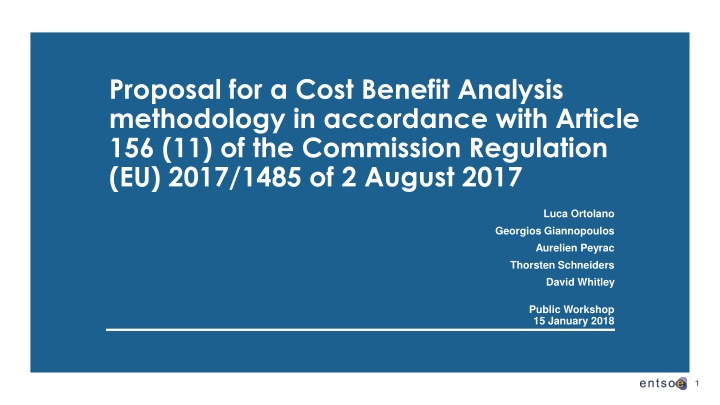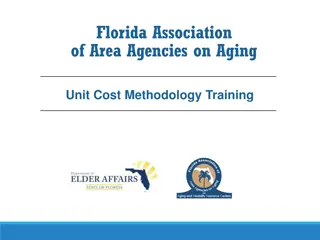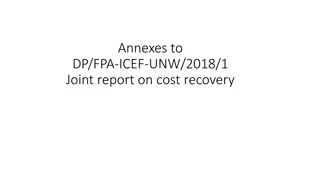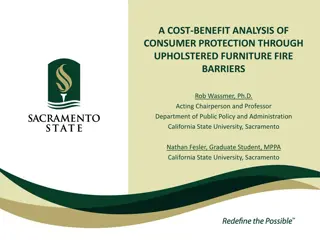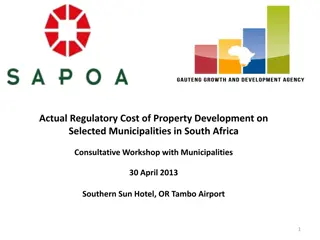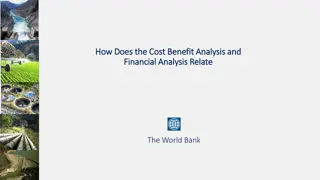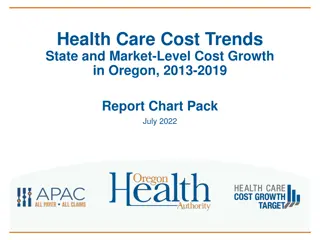Cost-Benefit Analysis Methodology as per EU Regulation 2017/1485
This proposal outlines a comprehensive Cost-Benefit Analysis (CBA) methodology in line with Article 156(11) of the Commission Regulation (EU) 2017/1485. The methodology is designed to address the requirements for Frequency Containment Reserve (FCR) and Limited Energy Reservoirs (LER) within the regulatory framework. It aims to consider various factors such as emerging technologies, cost implications, system stability risks, and technological developments to evaluate the effectiveness of FCR reserves. The workshop agenda includes an introduction to the workshop, CBA methodology explanation, compliance with regulatory articles, and a Q&A session to ensure clarity and understanding among stakeholders.
Download Presentation

Please find below an Image/Link to download the presentation.
The content on the website is provided AS IS for your information and personal use only. It may not be sold, licensed, or shared on other websites without obtaining consent from the author.If you encounter any issues during the download, it is possible that the publisher has removed the file from their server.
You are allowed to download the files provided on this website for personal or commercial use, subject to the condition that they are used lawfully. All files are the property of their respective owners.
The content on the website is provided AS IS for your information and personal use only. It may not be sold, licensed, or shared on other websites without obtaining consent from the author.
E N D
Presentation Transcript
Proposal for a Cost Benefit Analysis methodology in accordance with Article 156 (11) of the Commission Regulation (EU) 2017/1485 of 2 August 2017 Luca Ortolano Georgios Giannopoulos Aurelien Peyrac Thorsten Schneiders David Whitley Public Workshop 15 January 2018 1
Workshop Agenda Introduction to the workshop Purpose of the workshop Regulatory Framework CBA methodology explanation (with Q&A) Compliance with Article 156(11)(a)to(e) Q&A Page 2
Introduction Purpose of the workshop Regulatory framework 3
Introduction Purpose of the workshop To inform all the involved parties about the CBA methodology proposal To describe the rationale of the solutions proposed in the CBA methodology To define the core issues To describe the future work and next steps of the CBA methodology Page 4
Introduction Regulatory Framework SO GL - title V describes the requirements for Frequency Containment Reserve Under title V, art. 156 describes FCR provision requirements, also for Limited Energy Reservoirs (LER) In particular, about LER art. 156(9) prescribes that: For the CE and Nordic synchronous areas, each FCR provider shall ensure that the FCR from its FCR providing units or groups with limited energy reservoirs are continuously available during normal state. For the CE and Nordic synchronous areas, as of triggering the alert state and during the alert state, each FCR provider shall ensure that its FCR providing units or groups with limited energy reservoirs are able to fully activate FCR continuously for a time period to be defined pursuant to paragraphs 10 and 11. [ ] Art. 156(10) and 156 (11) requires that CE and Nordic SAs TSOs shall develop a proposal concerning the minimum activation period to be ensured by FCR providers which shall consider the results of a CBA Page 5
Introduction Regulatory Framework Article 156 (11) of SO GL The aforementioned CBA shall take into account at least: a) experiences gathered with different time frames and shares of emerging technologies in different LFC blocks; b) the impact of a defined time period on the total cost of FCR reserves in the synchronous area; c) the impact of a defined time period on system stability risks, in particular through prolonged or repeated frequency events; d) the impact on system stability risks and total cost of FCR reserves in case of increasing total volume of FCR reserves; e) the impact of technological developments on costs of availability periods for FCR from its FCR providing units or groups with limited energy reservoirs. Page 6
Introduction Regulatory Framework In order to accomplish the requirements under article 156 ENTSO-E constituted a project team with members of both SAs CE and Nordic with the goal of editing the CBA for FCR provision by LER. The public consultation of the CBA methodology proposal will last 1 month: from January 10th to February 18th The consulted CBA shall be sent to all NRAs by 6 months from the SO GL entry into force (14th of March 2018) Page 7
Introduction Regulatory Framework Sep 2017 11- 15 January 2018 February 2018 March 2018 Activity 6- 10 13- 17 20- 24 27- 1 8- 12 15- 19 22- 26 29- 2 5-912- 19- 23 26- 2 5-912- 19- 23 26- 30 1-5 16 16 SO GL entered into force TSOs shall present a CBA methodology proposal within 6 months CBA Methodology Proposal publication 18 Feb Public Consultation 15 Jan, Brussels (Public workshop) 10 Jan Review acknowledgment TSOs shall present CBA results by 12 months from NRAs approval Submission to NRAs and publication CBA calculation 14 Mar Milestone Today Page 8
CBA Methodology Proposal Description of objectives, assumptions and analyses 9
CBA Methodology Proposal Overview Objective of the CBA methodology: FCR costs estimation and dimensioning without jeopardising the system stability. Considered variables are defined by varying: - Time period, - LER share - FCR needed amount The output of the methodology will then be the time period that minimizes the costs of FCR for each LER share. Page 10
CBA Methodology Proposal Overview Page 11
CBA Methodology Proposal Overview The CBA proposes an iterative workflow useful to assess the needs of increase in FCR dimensioning due to the presence of LER. The workflow exploits a Monte Carlo probabilistic approach. The increased FCR requirements are used in order to assess the costs related to the LER presence. Page 12
CBA Methodology Proposal Simulation model Page 13
CBA Methodology Proposal Simulation model Page 14
CBA Methodology Proposal Input data The CBA methodology takes into account the following prolonged or repeated frequency events: 1. Deterministic frequency deviation deviations at the change of the hour 2. Long lasting frequency deviation events Probabilistic model based on Monte Carlo approach 3. Outages Probabilistic model based on Monte Carlo approach Page 15
CBA Methodology Proposal Input data 1. Deterministic frequency deviations Are phenomenon where difference of power between load and generation are stressed by schedule exchange at the change of the hour. They usually occur several times every day. The main characteristic of these deviations is that they occur in specific periods during the day, with specific trend patterns. Page 16
CBA Methodology Proposal Input data 1. Market induced effects The deterministic frequency deviations considered in the FCP assessment will be obtained by analysing historical frequency deviations recorded by TSOs in the last 15 years, 2017 included. Potential overlap with recorded outages will be investigated in order to avoid double counting of phenomena. Page 17
CBA Methodology Proposal Input data 2. Long lasting frequency deviation events Frequency trend on 26 January 2016 During the operation of each synchronous area, some events in which the frequency deviation cannot be restored to 50 Hz by FRP can occur (even without the triggering of an alert state). Long lasting frequency deviation is defined as an event with an average steady state frequency deviation larger than the standard frequency deviation over a period longer than the time to restore frequency Page 18
CBA Methodology Proposal Input data 2. Long lasting frequency deviation events Frequency trend on 21 September 2017 Long lasting frequency deviations are typically related to the exhaustion of FRR in a single LFC area. On a single LFC area, the total amount of available FRR of that area is already activated, and part of the power imbalance is constantly balanced by FCR with consequent long lasting deviation. This kind of events shall be taken into account since they may overlap with other sources of frequency deviation such as outages. Potential overlap with recorded outages will be investigated in order to avoid double counting of phenomena. Page 19
CBA Methodology Proposal Input data 3. Outages The power imbalance due to outages is calculated starting from a list of possible contingencies with their own probability of occurrence. Probability of occurrence of outages by type of event and by generation technology shall be obtained by means of statistics about historical data considering at least: ENTSO-E transparency platform data; Information collected in the LFC report related to the most relevant power imbalances (power imbalances greater than 1000 MW); Research studies based on statistics of unit failure. Page 20
CBA Methodology Proposal Input data 3. Outages Contingency events (combination of outages and long lasting frequency deviation events) are considered as stochastically independent from each other. This is an approximation of the real system operation, in fact a correlation between outages and significant frequency deviation caused by other factors could occur. E.g. An untimely trip of a generation unit can be caused by the activation of its under frequency protection, increasing the power imbalance even during critical conditions. Page 21
CBA Methodology Proposal Workflow overview Page 22
CBA Methodology Proposal Model for probabilistic frequency simulations The core of the workflow is a Monte Carlo model able to simulate the Load-Frequency Control Process of a whole synchronous area. The model is capable to simulate an high numbers of years in order to explore the domain of possible operational conditions of the system. The aim is to test the effects of LER presence taking into account the largest possible number of operational condition that might occur in the real system. Page 23
CBA Methodology Proposal Model for probabilistic frequency simulations The input data considered for calculating the probabilistic frequency shall be: FCR: total amount of FCR in the synchronous area. FRR: Full Activation Time; A list of considered outages for the synchronous area with the correspondent probability of occurrence; The statistical information related to long lasting frequency deviation events; The deterministic frequency deviations Page 24
CBA Methodology Proposal Model for probabilistic frequency simulations The results of the model are frequency trends in all the conditions simulated with the Monte Carlo method. Page 25
CBA Methodology Proposal Monte Carlo approach
CBA Methodology Proposal Monte Carlo approach Monte Carlo approach The power imbalance due to outages is calculated using Monte Carlo random draws, starting from the occurrence probability of each event. While deterministic frequency deviations are direct input, the long lasting frequency deviations are considered as probabilistic events and they are drawn starting from the statistical analysis of occurrence. Page 27
CBA Methodology Proposal Monte Carlo approach Monte Carlo approach Deterministic frequency deviations, long lasting frequency deviations and power imbalance due to outages represent the input of a deterministic dynamic simulation model; The dynamic model calculates the frequency trend, taking into account all the scenarios data (e.g. Tmin LER, LER share, horizon year). Frequency trends of all the simulated years are analysed in order to assess system stability in the simulated condition. Page 28
CBA Methodology Proposal Dynamicsimulation model Page 29
CBA Methodology Proposal Dynamicsimulation model assumptions A main issue that should be evaluated in order to define a proper simulation model for the FCR provision analysis is related to the timescale of phenomena involved. FCR dynamic response System inertia FRR dynamic response Neglected Neglected Considered The presence of LER has an effect on the system once the energy reservoir is depleted. SO GL Article156(10): depletion must occur not before 15 minutes after the triggering of an alert state or, in case of frequency deviations that are smaller than a frequency deviation requiring full FCR activation, for an equivalent length of time. Effects of LER providers depletion take place on a timescale much larger than the timescales in which inertia and FCR dynamic response show their effects. The presence of LER FCR providers does not affect the system frequency in this context, since LER FCR provider deliver their reserve regardless of their reservoir. 30
CBA Methodology Proposal Dynamicsimulation model assumptions FRP simulation assumptions Model features Assumptions The entire Cross-Border Load-Frequency Control Process could be then neglected The model simulates the system of the whole synchronous area FRP is modeled with a single controller with a Full Activation Time (FAT) calculated as an average of the FAT of all the LFC areas belonging to the synchronous area weighted on FRR K-factor Simulated FRP operates only on the disturbances caused by the outages as both Standard Frequency Deviations and Long Lasting Frequency Deviations already implicitly involve an activation of FRR FRR is considered without limitations FRR-exhaustion-related phenomena are taken into account in the Long Lasting Frequency Deviation. Page 31
CBA Methodology Proposal Dynamicsimulation model Simplified FCR and FRR dynamic simulation in the time domain All the scenarios data are taken into account (e.g. horizon year, LER, etc.) Depletion effects of LER are simulated Page 32
CBA Methodology Proposal Dynamicsimulation model The model simulates the system of a whole synchronous area, the entire Cross-Border Load- Frequency Control Process is then neglected. The whole Frequency Restoration Process of the synchronous area is modeled with a single controller with an average Full Activation Time (FAT). FRR saturation is neglected. Page 33
CBA Methodology Proposal Dynamicsimulation model The FCR saturation block models the limited availability of FCR of the synchronous area. The System Frequency Behaviour block models the relationship between power imbalance and frequency deviation Page 34
CBA Methodology Proposal Simulation of energy depletion of LER Pursuant to Art.156(9) the time period shall be ensured as of triggering the alert state and during the alert state . However the storage capacity associated to a time period is exploited also in pre alert state. Page 35
CBA Methodology Proposal Simulation of energy depletion of LER SA CE The LER are considered without energy limitations while frequency remains inside the standard frequency range Once the simulated frequency exceeds this range, the model starts to calculate the activated energy and the residual energy in the reservoir Energy consumption Page 36 Example considering CE synchronous area
CBA Methodology Proposal Simulation of energy depletion of LER SA CE The starting value of the reservoir energy level will be equal to half of the equivalent reservoir energy capacity (Emax): Emax= 2 Tmin LER FCRLER [MWh] 60 where FCRLER is the FCR provided by LER [MW] Energy consumption Page 37 Example considering CE synchronous area
CBA Methodology Proposal Simulation of energy depletion of LER SA Nordic Energy consumption Page 38 Example considering Nordic synchronous area
CBA Methodology Proposal LER depletion acceptance criterion LER depletion is acceptable only if it never brings to a saturation of FCR. LER depletion shall never entail the steady state frequency to overcome the maximum steady state frequency deviation. If a LER depletion occurs, the FCR provided by LER disappears. The FCR previously provided by LER must be replaced by residual non-LER. In high LER penetration scenarios, the requirement entails that it must never occur an energy depletion. Page 39
CBA Methodology Proposal LER depletion acceptance criterion Not acceptable situation FCR increase Acceptable situation Page 40
CBA Methodology Proposal Iterative dimensioning process The workflow contains an iterative process in which, if the requirement on LER depletion is not fulfilled, the FCR amount is gradually increased. The iterative process stops once the requirement on LER depletion is fulfilled. Page 41
CBA Methodology Proposal Costs calculation Costs Calculation Page 42
CBA Methodology Proposal Costs calculation Page 43
CBA Methodology Proposal Costs calculation FCR increase considerations It is possible that when Tmin LER decreases, a greater volume of FCR is needed to fulfil the stability requirements. The FCR increase has only the aim to assess system stability risks and total cost of FCR in case of increasing total volume of FCR as requested by Article 156 (11 d) of the SO GL. The FCR dimensioning is defined in Article 153 of SO GL, therefore it cannot be the subject of this CBA methodology. FCR costs will be estimated during implementation phase. Page 44
CBA Methodology Proposal FCR cost curves assumptions A competitive FCR market reflects the costs of FCR provision. A single cost curve is taken into account for each synchronous area. Page 45
CBA Methodology Proposal Effects of time period on cost curves A decrease of Tmin LER can have a dual effect on the system costs: The required FCR could increase to fulfil the condition of replacing a LER depletion. Since a smaller Tmin LER could entail lower investment costs for the LER, the costs curve varies: the costs of FCR provided by LER decrease The combination of the two effects changes the overall FCR system cost. Page 46
CBA Methodology Proposal FCR cost curves The data needed to build the curve are: Energy market results (energy market prices); An estimation of production marginal costs of the different generation technology present in the synchronous area; An estimation of the investment costs for LER plants. Conventional non-LER costs LER costs Page 47
CBA Methodology Proposal Conventional non-LER costs The FCR cost per unit is the absolute value of: Energy Price Marginal Cost For a unit with high marginal cost EP MC is negative. As result BSPs have to cover the difference EP MC via FCR. For a unit with low marginal cost EP MC is positive. As result BSPs have to cover the opportunity cost via FCR. Page 48
CBA Methodology Proposal LER costs The FCR cost for LER is proportional to investment costs. If the Tmin LER increases, the LER must have a higher energy/power ratio. Page 49
CBA Methodology Proposal Scenarios Scenarios Page 50
